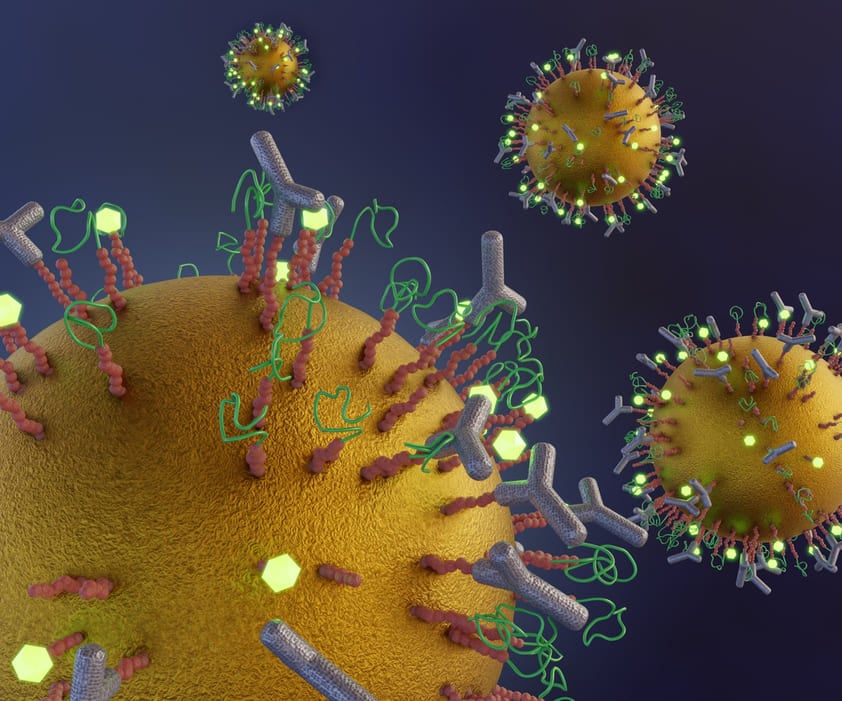In the recent decades, proteins gained importance after the advent of more advanced analytical procedures and novel genetic or molecular engineering methods. Proteins are cell products and have various physiological functions in the body. Hence, any abnormality in gene expression (mRNA defects), amino acid sequence or structural dysfunction of proteins leads to severe diseases and pathological conditions.
mRNA accounts for only 1-5% of the total cellular RNA, implying the importance of its isolation technique to be more reproducible, efficient, reliable, time and cost-effective and faster. The isolation of mRNA is an important step before various biological and diagnostic processes and downstream applications cannot be carried out with the crude sample material. mRNA has many medical applications nowadays, as the recently marketed COVID-19 vaccine is the first ever mRNA vaccine.
What are magnetic beads?
Magnetic beads are composites (typically >500nm) of a no-magnetic matrix (polystyrene, silica, PVA) charged with magnetic nanoparticles (usually magnetite about 10 nm). Surface coating is a feature of magnetic beads rendering them a very useful tool for molecular and immunodiagnostic applications such as gene cloning, gene expression analysis, cDNA synthesis, cDNA library construction, RT-PCR, quantitative RT-PCR, etc.
In surface coating, the surface of the bead is modified with different ligands or chemistries which have affinity toward only a specific cell by recognizing its surface receptor. This in turn minimizes their non-specific binding. This feature has been used for messenger RNA (mRNA) isolation and purification using oligo-dT-coated magnetic beads.
Oligo-dT: what is it?
Oligo-dT are oligonucleotides containing a short segment of repeating deoxythymidine (dT) and used as a primer for complementary DNA (cDNA) synthesis (reverse transcription). In oligo-dT primers, the dT anneals to the 3’ end of polyadenosine (polyA) tails of mRNA. They are template-specific, that is Ribosomal RNA (rRNA), DNA, proteins, and small RNA molecules (such as transfer RNA (tRNA), micro RNA (miRNA), and small nucleolar RNA (snoRNA)) do not bind the beads and are discarded, and also are not suitable for RNA lacking poly-A tail or degraded RNA.
On the other hand, oligo-dT-coated magnetic beads are used for small-scale, rapid isolation and purification of mRNA from crude eukaryotic samples (e.g. tissue, blood, cell extracts and cultivation media) and total RNA preparations.
Advantages of oligo-dT-coated magnetic beads for mRNA isolation and purification
The conventional chromatographic columns pose a challenge for mRNA isolation and purification such as numerous extraction and centrifugation steps creating shear forces leading to mRNA degradation or denaturation, small yields and low purities of products, time-consuming, loss of sample, cross-contamination with multiple samples, filter clogging or over-loading of columns, and not suited for automation and up-scaling.
Magnetic beads, on the other hand, offer a column-free system yielding the highest recovery and enrichment of mRNA. Due to their tiny size, they do not aggregate or precipitate during the procedure, leading to a uniform product. They have no washing steps with an easy procedure to perform.
Magnetic beads do not require total RNA or any other purification steps when the intended information is carried by mRNA. They are the best choice for automation and applicable in 24, 96, and 384-well plates. The isolated mRNA is intact and pure as only polyadenylated RNA species (mRNA) are captured, eliminating the need for ribosomal RNA subtraction or a post-extraction DNase treatment.
They offer a fast and gentle procedure yielding high affinity, selectivity and throughput. The isolated mRNA can be used for cDNA library construction from a single cell. The bound mRNA to the mobile beads can easily be immobilized and separated using a magnetic field. They offer a semi-continuous procedure with low energy and large-scale purification.
Magnetic beads don’t require organic solvents and centrifugation, vacuum filtration or column separation, which minimizes sample cross-contamination and stress or shear force on the target molecules. They still function with samples of low volume and viscous suspensions. Magnetic beads can be used for the recovery of small particles in the presence of biological debris and other cellular materials of similar size.
Oligo-dT-coated magnetic bead-based mRNA isolation
The introduced oligo-dT-coated magnetic beads bind mRNA in a mobile state of the sample. An external magnetic force attracts and immobilizes the mRNA-bound beads to the outer edge of the tube, while the remnants and contaminants are washed away. Finally, the elution step releases the mRNA from the beads in a pure form and the magnetic field is removed.
Related news
- How to choose a protein purification system
- Limitations and perspectives of Chemiluminescent immunoassay (CLIA)
- Spin Column





